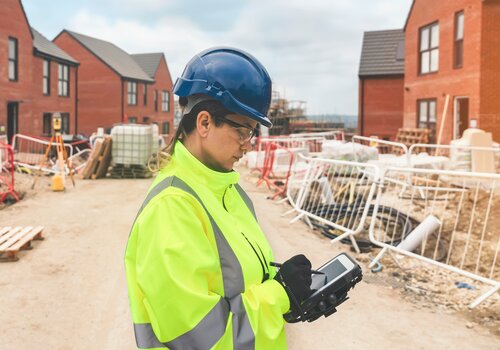In recent years, construction contractors have increasingly turned to technology to address industry challenges such as labor shortages, rising material costs and the demand for sustainable building practices. The technological landscape in construction is evolving rapidly, and contractors are dedicating more capital to integrating cutting-edge tools into their workflows. From automation and robotics to Building Information Modeling (BIM) and 3D printing, technology is reshaping how construction projects are managed, executed and maintained.
CONSTRUCTION TECHNOLOGY SPENDING IN 2024
As of 2024, construction contractors are spending billions of dollars globally on technological advancements. The trend is driven by the need for efficiency and sustainability, as well as the pressure to meet increasingly stringent regulatory requirements for safety and environmental impact. In the U.S. alone, the construction technology market has seen significant growth. Contractors are investing in solutions like drones, AI-driven analytics and cloud-based software to improve project management, reduce errors and ensure the timely completion of projects.
Key Areas of Investment:
- Building Information Modeling (BIM): BIM continues to be one of the most significant areas of investment in the construction industry. It allows contractors to create detailed digital representations of buildings before construction begins. These models help identify potential design flaws, streamline communication among stakeholders and improve the accuracy of project execution.
- Automation and Robotics: Automation technologies, including robotics, are being used to handle repetitive or labor-intensive tasks such as bricklaying, welding and even site surveying. These machines not only speed up processes but also enhance precision, reducing human error and waste.
- 3D Printing: Once considered futuristic, 3D printing has become a viable option for creating structures and architectural elements. This technology minimizes material waste and allows for more flexibility in design, leading to reduced construction timelines and costs.
- Drones and AI Analytics: Contractors are increasingly using drones for site surveys, inspections and progress tracking. Coupled with AI, these tools can provide valuable insights by analyzing data to predict project risks, optimize resource allocation and avoid costly delays.
Technology Adoption Drivers
Several factors are driving the increase in technology adoption within the construction industry:
- Workforce Shortages: The construction industry is facing significant labor shortages. By 2024, experts predict that the number of skilled workers will continue to dwindle, making it harder for contractors to meet demand. Technology, such as automation and robotics, helps bridge this gap by enabling contractors to complete tasks with fewer workers.
- Sustainability Goals: Sustainability has become a critical issue in construction, with companies striving to reduce their carbon footprints. Technologies like BIM, 3D printing and AI enable more efficient use of resources, reducing waste and energy consumption on-site.
- Cost Reduction: Contractors are under constant pressure to reduce costs and improve margins. Technologies that streamline project management, improve accuracy and minimize waste are vital to achieving this goal. For example, BIM allows contractors to identify potential problems before construction begins, avoiding costly rework later in the project.
MAXIMIZING THE VALUE OF TECHNOLOGY INVESTMENTS
While the benefits of construction technology are clear, making the most of every dollar spent requires strategic planning and careful consideration. Here are several tips for contractors to maximize their return on investment (ROI):
- Start Small and Scale Gradually
When adopting new technology, it’s wise to start with scalable solutions. For example, implementing BIM on smaller projects before rolling it out company-wide can help contractors understand its full potential while mitigating risk. Technologies like drones or AI analytics can also be introduced incrementally, allowing firms to gauge their effectiveness without committing to a large upfront investment. - Focus on Training and Education
Technology is only as effective as the people using it. To fully capitalize on technological investments, contractors need to ensure their workforce is adequately trained. This not only includes technical training on new tools but also fostering a culture of innovation where workers are encouraged to adopt new ways of doing things. Investing in ongoing education helps employees stay up-to-date with advancements, allowing contractors to maximize the use of their tools. - Leverage Data to Drive Decision-Making
One of the greatest advantages of construction technology is the ability to collect and analyze data. Contractors can use predictive analytics to identify potential issues before they occur, helping them make more informed decisions that minimize risk and reduce costly errors. Whether through drone-generated site surveys or BIM analytics, data-driven insights can significantly improve project outcomes. - Prioritize Technologies that Offer Long-Term Savings
When evaluating which technologies to invest in, contractors should prioritize solutions that offer long-term benefits, even if the upfront costs are higher. For instance, while 3D printing technology may have significant initial expenses, its ability to reduce material waste and construction time can lead to substantial savings over the lifecycle of a project. Similarly, robotics and automation can lead to lower labor costs and reduced downtime, providing long-term value. - Collaborate with Technology Partners
Partnering with technology providers can be an effective way to ensure smooth implementation and maximize ROI. Many tech firms offer training, support and customization services that can help contractors get the most out of their investments. By collaborating closely with these partners, contractors can tailor solutions to their specific needs, ensuring the technology aligns with their business goals.
In 2024, construction contractors are investing heavily in technology to meet the demands of a rapidly changing industry. From BIM and automation to AI and robotics, the potential for efficiency gains, cost savings and sustainability improvements is enormous. However, to make the most of these investments, contractors must adopt a strategic approach—starting small, focusing on training, leveraging data and collaborating with technology partners. By doing so, they can ensure that every dollar spent on technology contributes to better project outcomes and long-term success.
Photo credit: FRIENDS STOCK/BIGSTOCK.COM












